Paintings presented here were developed from encounters with the Ayasofya Musesi in Istanbul. It was Emperor Justinian who in 537 ordered the building of Hagia Sophia---the proximation of which remains standing to this day. He could rightly say that he had outdone Solomon, such was its splendor---that God almighty might be tempted to descend among men and dwell within it. Nearly fifteen centuries later I walked through its massive doors, humbled by the vastness of space with its suffused, sanguine light, imagining how people had the courage to construct it---this emblem of heaven on earth.
Decisively capturing my attention were massive marble revetments made from the most intriguing polychrome marbles, covering acres of interior walls. Raw material was quarried and transported to Constantinople from all corners of the Roman empire. Slabs of marble were book matched, meaning that quarried stone blocks cut with silk threads were sawn parallel to a surface, becoming unfolded panels, set edge to edge like the facing leaves of an opened book. The evidence of this costly process suggests Gestalt thinking, regarding perceptual organization, existing long before any formal theory was advanced---in this case that a form has symmetry and beauty which did not exist in either of the parts that make it up. The book matching of these magical proportions of marble, with their veined surface delineations, felt so utterly foreign---hardly rooted if not independent of human expression.
Hagia Sophia was originally built with no iconography. The Byzantium scholar Andrew Gould suggests that “it was principally these marbles that expressed the beauty of the kingdom of God. Reading latent images into the veining and shifting dynamism, the faithful could translate this propriety of these illusionary revelations, organized within an active surface.”
Making drawings of the revetment surfaces became the paradigm that would help provide discernment and a sense of familiarity with their curious symbolic subjectivities. Many hours on location were expended drawing stone patterns within the hushed intensity of Aya Sofia. It was back in Elsah however where I truly valued the making of these linear studies, and it was impossible to ignore substantial associations with them for transforming a painting’s content. But how could such compelling sketches, made in an arid, stony, and ancient region of a topographic culture be translated among humid waves of grain and the silty riverbanks of America’s Midwest?
A memory of the call to prayer which I had heard so many times in Istanbul became one of the mantras that prompted the making of drawings from the original stone surfaces, then to be eventually transfigured through small paintings on panel. These were followed by larger formats, metamorphosing on canvas a subject matter far less geologic and closer to home. The innumerable and diverse possibilities for sanctioning content through a book-match continues to sustain wonder, to be realized here in the Alton-Illinois studio, just as plausibly as within the telling hollows of Aya Sofia.




